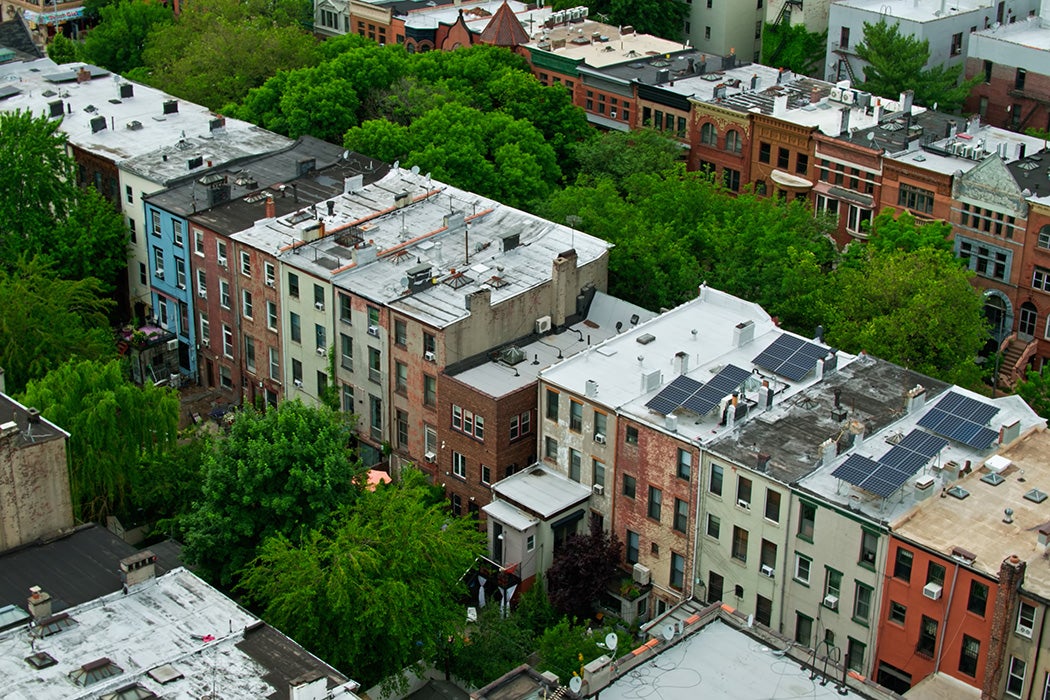Trees are more than just a pretty sight in urban environments. Nestled amidst sidewalks, pavement, and concrete, the sight of an oak or maple tree has always been a refreshing touch of home for me in a bustling city. Beyond their aesthetic value, trees provide numerous tangible benefits to the holistic environmental health of our communities. According to research conducted by a team led by Veniece Jennings, trees support the filtration of air pollutants that could otherwise damage human lungs, provide shade that lowers the urban heat island effect, and serve as refuges for biodiversity that can help serve as a natural buffer for disease and improve climate resiliency.
As cities around the world are experiencing the effects of anthropogenic climate change, including warmer summer air temperatures and more frequent and intense storms, governments are turning to trees and creating more canopy cover as a natural climate adaptation strategy. Even beyond their environmental benefits, trees are proven across multiple studies to have significant social benefits, such as enhancing human psychological well-being, improving mental and cognitive abilities, strengthening cardiovascular health, and reducing local crime rates.
Given the significant gifts and services that trees and greenery provide to their surroundings, their spatial distribution has resounding importance in achieving environmental justice. Racial inequalities in exposure to air pollutants, to the deliberate targeting of communities of color for heavy polluting industries and waste sites, make these same areas prime candidates for green infrastructure like trees. Yet, as Jennings et al. argue, due to legacies of racist redlining practices, exclusionary zoning, and discriminatory development, access to tree cover is disproportionately lower in low-income communities of color across the United States. Compounding factors such as home ownership rates and household income further exacerbate disparities in the distribution of urban tree canopy cover.
The consequences of this history are far-reaching, and they encourage us to consider how the deliberate placement (and non-placement) of trees as a form of systemic inequity has affected community health, wellness, and even economic outcomes. Historically, the lack of public investment in redlined communities means that trees weren’t planted in these areas, leading to a weaker, younger urban tree canopy today. As planning and ecology scholar Michael Drescher warns, “[t]he average life expectancy of an urban street tree is 19 to 28 y[ears], which means that many trees die before they can deliver substantial benefits.”
Drescher argues the importance of increasing the life expectancy of urban trees, wherever they might be planted. And while the presence of single or small groups of trees in a neighborhood is critical, intact forested areas in proximity to redlined communities are also a necessary part of urban tree canopy cover. Deforestation in favor of further development has affected these same communities, curtailing environmental and health benefits across generations of frontline communities. It also contributes to ongoing economic disparities: a healthy tree canopy can increase community property values, lower heating and cooling costs for residents, and lower health treatment costs of those experiencing asthma and cardiovascular disease.
Even when forested areas are present in vulnerable communities, they’re not always accessible to all residents and potential users. Issues such as safety concerns, costs of access (particularly parking and transit costs), the physical ability to explore these spaces, and cultural factors all influence whether a community can truly benefit from their presence, write Jennings et al. Without regular trail maintenance, benches, and accessible walking paths, people with different abilities won’t have equal access. In low-income areas, the perceived presence of crime, poorly maintained recreational spaces, and a lack of organized activities can further limit physical activity and engagement with green spaces, the research team argues.
Weekly Newsletter
When addressing such disparities, it’s important to approach tree planting and green initiatives with this history in mind. Where we plant and preserve trees matters, but intervening in communities without the involvement of residents and stakeholders can lead to unintended consequences. Engaging residents in the design and programming of green initiatives is essential, and planning for long-term maintenance by the municipality and governing bodies is critical to avoid placing additional burdens on them. Moreover, efforts to increase green spaces should include protections for communities against green gentrification, where the introduction of green infrastructure drives up property values and displaces long-time residents.
By centering the community in these decisions, cities can ensure that street trees and forested areas are not only accessible but also meet the needs and desires of the people who live there. This approach helps to create sustainable, inclusive, and resilient urban environments that promote both environmental and social equity.







